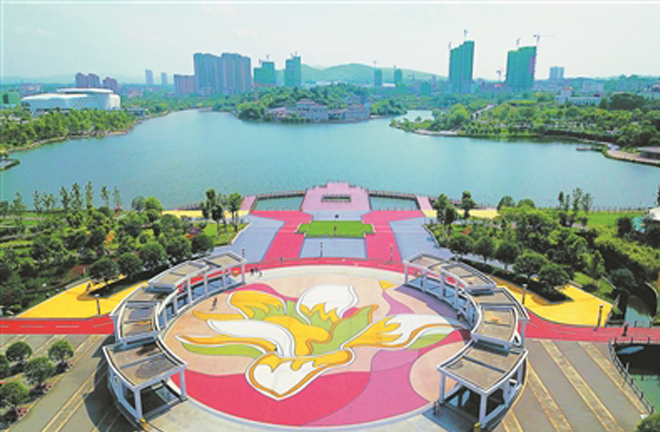‘Sponge city’ offers effective new urban water-resilience strategy

The Yuhu Park, which blends ecology and landscape together, is the first demonstration park of the sponge city construction in Pingxiang, Jiangxi Province. (PEOPLE’S DAILY ONLINE)
On May 9, Danish pump manufacturer Grundfos hosted a summit in Fuzhou City, Fujian Province on water ecology and the construction of “sponge city,” an urban planning concept aimed at building more water-resilient cities.
At the summit, Grundfos, together with Global Water Intelligence (GWI), a leading researcher for international water affairs, released the 2018 White Book on China’s Sponge City Construction which presented an overview of latest developments in sponge city construction citing five successful examples of the concept: Shanghai, Fuzhou, Tianjin, Guangzhou, and Pingxiang.
Waterlogging alleviation
As the report points out, Guangzhou has had early success in addressing waterlogging and its government plans to invest 2.3 billion yuan during 2017-2018 in managing 72 waterlogging sites of the city.
Just two days before the white book was released, Guangzhou was hit by heavy rainstorms, with more than 100 millimeters of rain falling within a few hours. But its citizens reported improvement in the amount of water saturating the streets.
The concept of sponge city was first proposed in China at the Forum for Low-Carbon City and Regional Development Technology hosted by Peking University in Shenzhen City in April 2012. In his speech to the Central Urban Work Conference in December 2013, General Secretary of the CPC Central Committee Xi Jinping reiterated the importance to enhance the urban drainage system and build the sponge city that is natural in water deposition, infiltration and purification.
The Ministry of Housing and Urban-Rural Development of China issued the Technical Guide to Sponge City Building in November 2014. The list of the first batch of pilot sponge cities was later released on April 2015, and the Guidelines on Promoting Sponge City Building were issued by the General Office of the State Council, which also put forward comprehensive water-recycling measures. The objective is that “70 percent of rainwater should be absorbed and reused through improved water permeation, retention and storage, purification and reuse and drainage.”
The 2017 Report on the Work of the Government further directed the way forward for the sponge city and proposed coordinated urban development above and below the ground. The report called for the country to begin construction on at least another 2,000 kilometers of underground utility tunnels in cities. A three-year initiative will be launched to reduce the risk of flooding in highly vulnerable urban areas. Further progress will be made in the development of sponge cities to make our cities more attractive and function better.
Sustaining water resource system
“Sponge” is usually used metaphorically by academia to describe certain absorptive function of a city, and denote the sound elasticity and resilience that a city possesses in tackling natural disasters and other water-related problems. “The idea is that you’d put water into it year after year and then pump it out when you get into a drought. The ground becomes your saving bank for water.” This is how Richard Luthy, a professor of civil and environmental engineering at Stanford University, defines sponge city.
As a unique strategy and method of water resource management, in what sense could building a sponge city achieve the sustainable development of the overall water resource system? Many scholars are optimistic about the concept. Xia Yongxiang, a professor from the Dongwu Business School at Soochow (Suzhou) University, said that building sponge cities would help reduce the pressure on the city’s existing drainage facilities, helping to conserve water resources. At the same time, the concept can prevent economic losses from floods and droughts. Wu Qiyan from the School of Public Policy and Administration at Xi’an Jiaotong University said a major concern in the construction of sponge cities is to deal with the complexity and coordination of a city’s subsystem of water recycling.
In the UN World Water Development Report 2018 released in March this year, the sponge city that China initiated was hailed as a good example of natural solutions. According to the report, China’s sponge city concept uses a combination of natural solutions and gray infrastructure to retain urban runoff for eventual reuse. The central policy planning, actively aligned with the local-level implementation, has integrated the sponge city concept into urban regulatory planning at city and district levels.
Improving urban ecological environment
In addition to addressing frequent waterlogging, water shortages, deterioration of the aquatic environment and other water-related problems, sponge city can draw a bigger picture of ecology to achieve a range of ecological benefits, such as modulating the urban climate, lowering the urban heat island effect and improving the living environment.
Zhang Xuehua, director of the Institute of Environmental Economy at Tianjin Polytechnic University said that the sponge city concept can make cities more natural, ecological, graceful and pleasant. By transforming the city into a sponge, the originally hard, stiff square could become where there is abundant water, scenery and natural ingenuity, improving the sense of happiness of neighboring residents.
Xia added that the green city concept is crucial for sponge city building, which also necessitates the lowering of the density of urban buildings and the reducing of the hardened area of the ground. The relationship between the renewal of old urban areas and the new urban construction should also be well tackled, said Xia.
Wu concluded that sponge city building not only concerns engineering practice and engineering science, but also is an issue of philosophy of science. To him, a sponge city is a complex macro-system with both natural and artificial attributes. To improve the planning and management of sponge cities, more disciplines and scholars should be encouraged to participate in the process of research, program argumentation, construction, implementation, and management.
ZHAO LU, BAI LE are correspondents with Chinese Social Sciences Today.
